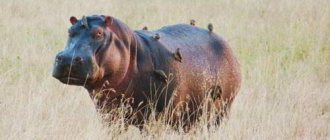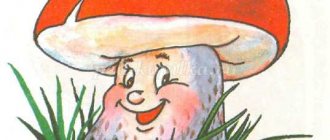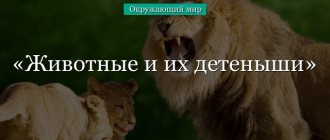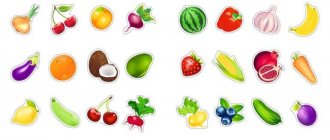Summary of an educational lesson in the preparatory group Topic “Pets”
Summary of educational lesson
in the preparatory group
Theme "Pets"
Target:
Consolidating children’s ideas about the appearance of domestic animals, their structure, habits, food, and the benefits they bring to people.
Tasks: Tasks:
Activate and enrich children's vocabulary on the topic.
Strengthen the ability to answer questions with complete, grammatically correct sentences.
Teach children to take care of poultry and animals Equipment:
pictures of pets, ball, Dunno toy.
Progress of the lesson
Educator: Guys, in front of you are pictures of animals. why
animals?
Children:-
These are animals, since the body is covered with hair,
4
paws or
4
legs, claws, muzzle, tail.
Educator:-
How are animal legs different from animal paws?
Children:-
The animal's legs have hooves, and the animal's paws have pads and claws.
Educator:-
Right. Find pictures of pets and name them.
(Children complete the task, naming pets)
Educator:-
Why are these animals called pets?
Children:-
These animals live next to the person who cares for them.
Educator:-
Right. How does a person care for animals?
Children:-
Man feeds, takes care of animals, benefits man
Educator:-
Children, do you know why horses sleep standing up? Scientists believe that horses developed the habit of sleeping standing up as a defense mechanism, a way to protect themselves from predators. Horses' speed is their primary means of defense in the wild, and a standing position keeps the horse in a state of readiness to run away when danger approaches. Animals with long legs take longer to rise from a lying position than others.
Game “Guess what animal”.
This animal has legs, hooves, a tail, and horns.
This animal has legs, hooves, a tail, and a mane. This animal has paws, whiskers, and a tail. This animal has bristles, a tail, and a snout. Ball game “Name the family”
Cow-bull-calf, etc.
(There are figurines of domestic animals on the table.
The teacher brings the children to the table)
Educator:-
One day, domestic animals gathered in a barnyard and began to argue which of them was needed more by man.
- Let's figure out what benefits each pet brings?
Ball game “Benefits of pets”
Fizminutka
"Calf"
Boo-boo, I'm horny. Two jumps. "Horns" made from fingers.
Boo-boo, I'm tailed. Two jumps. “Tail” from the hand - behind the back.
Boo-boo, I'm big-eared. Two jumps. “Ears” made from palms.
Boo-boo, Very scary Two jumps. "Horns" made from fingers.
Boo-boo, I'll scare you. Two jumps. They stomp.
Comparison of domestic and wild animals. Lesson in the preparatory group of kindergarten
Lesson
in the preparatory group of a kindergarten on the topic “Comparison of domestic and wild animals”
PROGRAM TASKS:
Clarify children’s understanding of familiar pets;
to form generalized ideas about domestic animals according to the following characteristics: they live together with a person, are not afraid of him, a person uses them on the farm, a person creates all the conditions for their life; show that domestic animals are different from wild ones - they are not adapted to live independently in the forest: they cannot take care of themselves, cannot obtain food, and cannot defend themselves well from enemies. Improve children's skills: explain, compare, prove, draw conclusions, apply knowledge in new situations. MATERIALS FOR THE CLASS:
a toy - a dog with a camera, an envelope with photographs of wild forest and domestic animals, diagrams - cards for three characteristics, a drawn silhouette of an animal on half a landscape sheet for each child and felt-tip pens.
Progress of the lesson:
Didactic pictures with wild and domestic animals are posted on the board.
Educator:
Hello, guys.
Children:
Hello.
Educator:
Guys, you probably all watched the cartoon “Holidays in Prostokvashino”?
And today the dog Sharik came to our kindergarten. He recently received a camera as a gift and decided to take up photography. But he is very bad at this idea. Since before he was a stray dog and did not study anywhere. Therefore, the dog Sharik turned to us for help so that we could help him learn more about his animal friends. And now we’ll check how well you guys know animals and whether you can solve the most difficult riddles about them. Listen carefully, if you know the answer, raise your hand. Whoever raises his hand first is the one who answers. Don't shout from your seat. So, here are the riddles: Who was gnawing on the pine cones on the branch? And threw the scraps down? Who deftly jumps along the Christmas tree and climbs the oak trees? Who hides nuts in a hollow and dries mushrooms for the winter? Children:
Squirrel.
Educator:
That's right.
This is a squirrel. The teacher asks the children to choose a picture of a squirrel on the board. Educator:
What kind of forest animal Stood up like a column under a pine tree And stands among the grass - Ears larger than head?
Children:
Hare.
Educator:
That's right. Hare. The teacher asks the children to choose a picture of a hare on the board.
Educator:
What dangerous animal walks around in a red fur coat, shovels snow, grabs mice?
Children:
Fox.
Educator:
That's right. It's about a fox. The teacher asks the children to choose a picture of a fox on the board.
Educator:
You stroke it and it caresses you, You tease it and it bites you.
Children:
Dog.
Educator:
That's right. Dog. The teacher asks the children to choose a picture of a dog on the board.
Educator:
The muzzle is mustachioed, the fur coat is striped, it washes itself often, it is not familiar with water.
Children:
Cat.
Educator:
That's right.
It's a cat. The teacher asks the children to choose a picture of a cat on the board. Educator:
In the summer he walks without a road near the pines and birches, and in the winter he sleeps in a den, hiding his nose from the frost.
Children:
Bear.
Educator:
Of course, a bear. The teacher asks the children to choose a picture of a bear on the board.
Educator:
And the last riddle: There is a haystack in the middle of the yard. There is a pitchfork in front and a broom in the back.
Children:
Cow.
Educator:
Yes, it's about a cow. The teacher asks the children to choose a picture of a cow on the board.
Educator:
Children, where does the cow live?
With a person or in the forest? Children: With a person. Educator:
Is a cow afraid of her owner?
Children: No, the person takes care of her. Educator:
How does a person take care of her?
Children: Builds housing, feeds, waters, makes hay. Educator:
How does he take care of her?
Children:
Cleans her room, washes and cleans the cow herself, milks on time so that the cow does not get sick.
Educator:
What benefits does a cow bring?
Children:
She gives milk, meat, the skin is used to make leather for making various things.
Educator:
Yes, that's right.
What products can be obtained from milk? Children:
Cottage cheese, sour cream, cheese.
Educator:
Children, since a cow lives with a person, he takes care of her, she brings benefits, so what kind of animal is a cow?
Children:
Pet.
Educator:
That's right.
And now I’ll tell you another riddle. Listen carefully. Touching the grass with his hooves, a handsome man walks through the forest, walking boldly and easily, with his horns spread wide. Children: This is a moose. Educator:
Absolutely right.
The teacher hangs a picture of a moose on the board. Based on the signs indicated above, children, together with the teacher, determine whether the animal is domestic or wild. Educator:
Could the cow survive in the forest?
Children:
No, I couldn’t.
Educator:
Why?
Children:
In winter she may freeze without a home;
it is not adapted to feed on dry branches and bark; cannot tear apart the snow with its hooves to find grass for itself; the cow has a bright color - the enemy will see it from afar, and it does not know how to run fast. Educator:
That's right, a cow is not suitable for life in the forest.
After all, all domestic animals that live next to a person need his care and would not be able to survive in the wild. Now imagine that we are in the forest, I will read a poem and perform the movements, and you repeat after me. We came to the autumn forest. (walking in place) There are so many miracles around here! On the right - a birch tree stands in finery, (move your hand to the side, the other) Leaf fall, leaf fall, Leaves are spinning and flying. (children spin around) So the bunny galloped up (jumping in place) He ran away from the fox. This is a gray wolf prowling (hands on his belt, bending to the sides) He is looking for prey. We will all hide now, (crouch) He won’t find us then! And here comes the gray hedgehog, he runs without paths. (running in place) The cranes fly away, (imitate the flight of birds) We will wait for them until spring! There is beauty in the autumn forest, (they spread their hands) And it’s time for us to go home. (sit down) Educator:
We’ve warmed up well, and now we’ll play the game “Who lives where?”
Guys, the dog Sharik took photographs of animals, but he does not know where the animals he photographed live. Let's help him put all the photographs into two envelopes and send them to the forest and the village. The teacher shows two envelopes. On one there are Christmas trees, and on the other there is a house. Educator:
I will now give you all photographs of animals, you must look at them carefully, determine whether it is a domestic animal or a wild one, and where it lives.
And the hint pictures will help you with this. Children distribute photographs of animals into envelopes. Educator:
Children, the dog Sharik still has negative pictures (not finished photographs), you must develop them - color them in order to find out who Sharik photographed.
The teacher hands out pictures for children to color. They get to work. Educator:
What great fellows you are! You managed to help Sharik, and he is very grateful to you. Now he will know exactly which animals live where.
Leave your comment
Gift certificates
Samara students will be taught by a robot
Reading time: 1 minute
Scientists make protein-shaped gummies to help blind children learn chemistry
Reading time: 2 minutes
The procedure for holding the All-Russian competition “Teacher of the Year in Russia” in 2022 has been approved
Reading time: 3 minutes
Every third student is behind in school
Reading time: 3 minutes
An Italian teacher gave children a summer assignment and became famous
Reading time: 4 minutes
Chinese University Enrolls Artificial Intelligence in Computer Science Faculty
Reading time: 1 minute
Responsibility for resolving any controversial issues regarding the materials themselves and their contents is taken by the users who posted the material on the site. However, the site administration is ready to provide all possible support in resolving any issues related to the work and content of the site. If you notice that materials are being used illegally on this site, please notify the site administration using the feedback form.
All materials posted on the site were created by the authors of the site or posted by users of the site and are presented on the site for informational purposes only. Copyrights for materials belong to their legal authors. Partial or complete copying of site materials without written permission from the site administration is prohibited! The opinion of the administration may not coincide with the point of view of the authors.
Source




